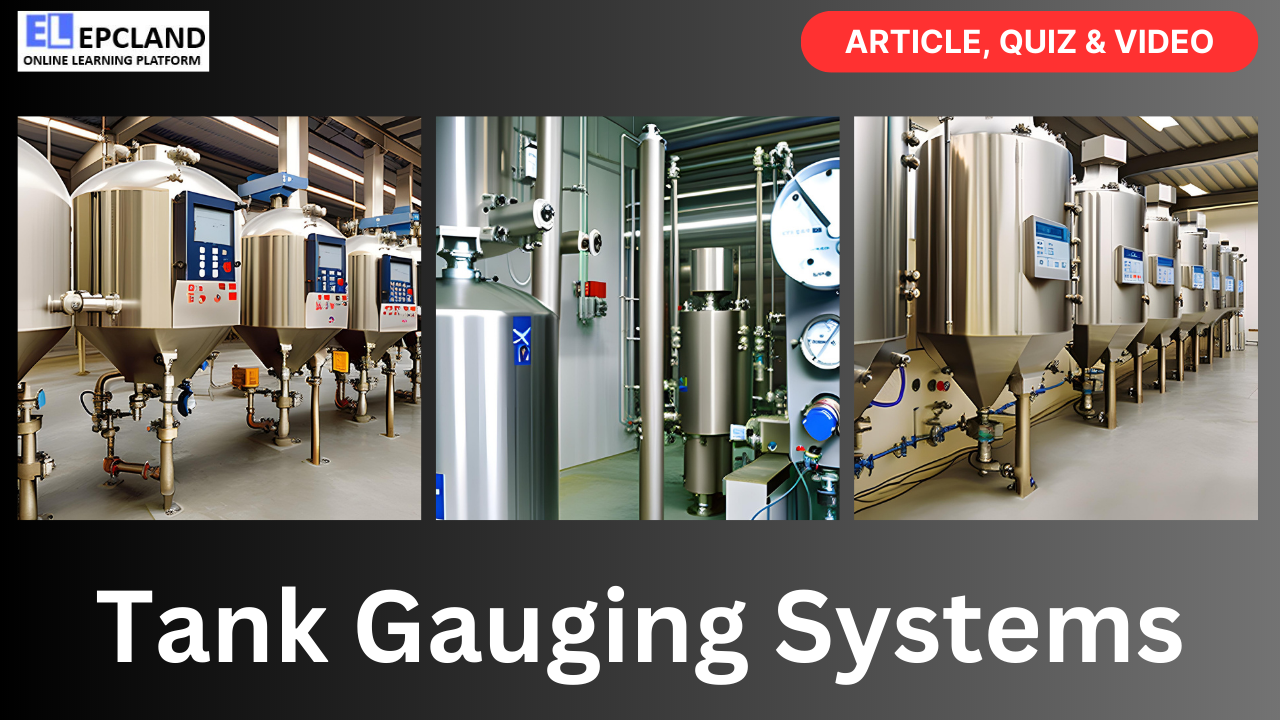In the vast and intricate world of the oil and gas industry, the precise measurement and monitoring of storage tanks’ contents are of utmost importance. Tank gauging systems have emerged as essential tools in ensuring the safe and efficient management of these critical assets. This article serves as a comprehensive guide to understanding tank gauging systems, their significance, types, components, and their role in oil and gas industry projects.
Table of Contents
Do not miss the detailed course 7 Modules of Piping Codes & Standards
Enrollment link
Introduction to Tank Gauging Systems
Tank gauging systems are a category of instrumentation used to measure and monitor the level, volume, temperature, and sometimes the pressure of liquids, gases, or solids stored in tanks. These systems provide real-time data, allowing operators to make informed decisions regarding inventory management, safety, and environmental compliance.
Significance of Tank Gauging in Oil and Gas
In the oil and gas industry, tanks are ubiquitous. They are used to store crude oil, refined products, natural gas liquids, chemicals, and various other substances. Accurate and reliable tank gauging is essential for several critical reasons:
1. Inventory Management
Knowing the exact volume of product in storage tanks is essential for supply chain management, production planning, and ensuring product availability.
2. Safety
Incorrect level measurements can lead to overfilling or underfilling, which can result in dangerous situations, including spills, leaks, and equipment damage.
3. Environmental Compliance
The industry is subject to strict regulations regarding emissions, leaks, and spills. Accurate tank gauging helps prevent environmental violations.
4. Loss Control
Efficient tank gauging minimizes losses due to evaporation, theft, or leakage, protecting both assets and profits.
5. Maintenance
Regular tank level monitoring helps identify maintenance needs and prevents costly downtime.
Types of Tank Gauging Systems
Tank gauging systems come in various types, each suited to different applications and environments. The choice of system depends on factors such as the type of product stored, tank size, and environmental conditions. Here are some common types:
1. Float and Tape System
The float and tape system is a traditional, manual method. It consists of a float connected to a tape that is manually lowered into the tank. The tape is marked with measurements, and the operator reads the level by observing the point where the float rests on the liquid’s surface. This system is cost-effective but can be labor-intensive and less accurate than automated systems.
2. Radar Tank Gauging
Radar tank gauging systems use radar waves to measure the distance from the sensor to the liquid surface. These systems are highly accurate and suitable for a wide range of products, including crude oil and petrochemicals. They can be installed externally or internally and provide continuous level monitoring.
3. Ultrasonic Tank Gauging
Ultrasonic tank gauging systems employ sound waves to determine the liquid level. They are non-intrusive and relatively easy to install. Ultrasonic systems work well for measuring clean liquids and are cost-effective.
4. Capacitance Tank Gauging
Capacitance tank gauging systems measure the change in capacitance between the tank wall and a probe inserted into the tank. This change corresponds to the level of the liquid. These systems are suitable for measuring liquids with low dielectric constants, such as hydrocarbons.
5. Hydrostatic Tank Gauging
Hydrostatic tank gauging relies on the principle that the pressure at the bottom of a liquid is directly proportional to the height of the liquid. Pressure sensors at the tank bottom measure this pressure, which is then converted to a level measurement. These systems are accurate but may require corrections for temperature and density variations.
6. Guided Wave Radar
Guided wave radar systems use radar waves guided along a probe inserted into the tank. They are suitable for various products, including those with foaming or agitating surfaces. Guided wave radar systems offer high accuracy and reliability.
Do not miss the detailed course 7 Modules of Piping Codes & Standards
Enrollment link
Components of Tank Gauging Systems
Tank gauging systems consist of several key components that work together to provide accurate measurements and data. These components may vary depending on the type of system used, but the following are common in most tank gauging systems:
1. Level Sensor
The level sensor is the core component responsible for measuring the level of the liquid in the tank. Depending on the system type, this sensor could be a radar antenna, ultrasonic transducer, capacitance probe, or another technology suited to the specific application.
2. Signal Conditioning Unit
The signal from the level sensor is often weak and needs amplification and conditioning before it can be processed. The signal conditioning unit performs this task, ensuring that the data is accurate and reliable.
3. Transmitter
The transmitter takes the conditioned signal from the level sensor and sends it to a remote control room or data collection point. It may also provide power to the level sensor.
4. Display and Control Unit
Operators and technicians need a way to view and interact with the tank gauging system’s data. Display and control units provide real-time level readings, alarms, and sometimes the ability to adjust settings.
5. Data Storage and Communication
Modern tank gauging systems often include data storage and communication capabilities. Data can be stored locally and transmitted to a central control room or cloud-based system for remote monitoring and analysis.
6. Alarms and Safety Systems
Tank gauging systems incorporate alarms to notify operators of critical conditions such as high or low levels, leaks, or overfills. Safety systems can trigger shutdowns or other safety measures in emergencies.
7. Software and Visualization Tools
Specialized software allows operators to monitor tank levels, trends, and historical data. Visualization tools, such as graphical representations of tank levels, make it easier to interpret the information.
Applications of Tank Gauging Systems in Oil and Gas Industry Projects
Tank gauging systems find wide applications in the oil and gas industry across various project phases and operations:
1. Upstream Operations
In the upstream sector, which includes exploration and production, tank gauging systems are used to monitor storage tanks for crude oil and natural gas liquids. Accurate level measurements ensure that tanks are not overfilled, preventing spills and environmental damage. Additionally, they help optimize production by ensuring that tanks are filled to optimal levels.
2. Midstream Operations
Midstream operations involve the transportation of oil and gas from production sites to refineries or distribution centers. Tank gauging systems are crucial for monitoring the levels of pipelines and storage tanks along the transportation route. This data helps in managing inventory, preventing leaks, and ensuring safe transportation.
3. Downstream Operations
In downstream operations, which include refining and distribution, tank gauging systems play a vital role in managing various types of storage tanks, including those used for refined products such as gasoline and diesel fuel. Accurate measurements are essential for inventory control, quality assurance, and preventing overfills.
4. Petrochemical Industry
The petrochemical industry relies heavily on tank gauging systems to monitor the levels of various chemicals and feedstocks stored in tanks. These systems help optimize production processes and ensure the availability of raw materials.
5. Terminal Facilities
Terminal facilities serve as storage and distribution hubs for oil and gas products. Tank gauging systems are essential for managing large tank farms efficiently. They help operators track inventory, plan shipments, and ensure the safe loading and unloading of products.
6. Environmental Compliance
In the oil and gas industry, environmental regulations are stringent. Tank gauging systems assist in complying with these regulations by preventing spills, leaks, and overfills that can lead to environmental contamination.
Emerging Technologies in Tank Gauging
As technology advances, tank gauging systems continue to evolve. Several emerging technologies are making waves in the industry:
1. Wireless Communication
Wireless communication allows tank gauging systems to transmit data without the need for physical cables. This technology reduces installation costs and enables remote monitoring of tanks in remote or hazardous locations.
2. Internet of Things (IoT) Integration
IoT technology is increasingly being integrated into tank gauging systems. IoT sensors can provide real-time data on tank levels, temperature, and other parameters, enabling predictive maintenance and remote monitoring.
3. Advanced Data Analytics
Advanced data analytics tools are being used to process the vast amounts of data generated by tank gauging systems. These tools can identify trends, predict maintenance needs, and optimize inventory management.
4. Artificial Intelligence (AI) and Machine Learning
AI and machine learning algorithms can analyze historical data to predict tank behavior, such as levels during various weather conditions or product quality changes over time. These predictions can inform decision-making and improve efficiency.
Challenges and Future Trends
While tank gauging systems have come a long way, they still face several challenges and will continue to evolve to meet future trends:
1. Accuracy and Calibration
Maintaining high levels of accuracy in tank gauging systems is crucial. Regular calibration is necessary to ensure that measurements remain reliable, especially in harsh environmental conditions.
2. Cybersecurity
As tank gauging systems become more connected, they are vulnerable to cybersecurity threats. Protecting these systems from hacking and data breaches is a growing concern.
3. Integration with Industry 4.0
The industry is moving towards Industry 4.0, with increased automation and data-driven decision-making. Tank gauging systems need to seamlessly integrate with these broader digitalization efforts.
4. Sustainability
Environmental concerns are driving the need for more sustainable practices. Tank gauging systems can contribute by helping reduce losses and emissions.
Conclusion
Tank gauging systems are the unsung heroes of the oil and gas industry, providing critical measurements that enable efficient operations, prevent environmental disasters, and ensure safety. Whether in upstream, midstream, or downstream operations, these systems play a fundamental role in managing the industry’s vast network of storage tanks.
As technology continues to advance, tank gauging systems will become even more integral to the industry. Wireless communication, IoT integration, advanced analytics, and AI are shaping the future of tank gauging, allowing for more efficient and sustainable operations.
In conclusion, the oil and gas industry would not be what it is today without the precise measurements and real-time data provided by tank gauging systems. These systems are not just instruments; they are the guardians of an industry that relies on precision, safety, and environmental responsibility.
FAQs
- What is a tank gauging system in the oil and gas industry?A tank gauging system is an instrumentation system used to measure and monitor the level, volume, temperature, and sometimes pressure of liquids, gases, or solids stored in tanks within the oil and gas industry.
- Why are tank gauging systems important in the oil and gas industry?Tank gauging systems are crucial for inventory management, safety, environmental compliance, loss control, and maintenance in the industry. They ensure precise measurement of tank contents and prevent overfills or spills.
- What are the different types of tank gauging systems used in the industry?Common types of tank gauging systems include float and tape, radar, ultrasonic, capacitance, hydrostatic, and guided wave radar systems. The choice depends on factors like the type of product stored and environmental conditions.
- What are the key components of a tank gauging system?A typical tank gauging system consists of components such as a level sensor, signal conditioning unit, transmitter, display and control unit, data storage and communication, alarms, safety systems, and software for data analysis and visualization.
- Where are tank gauging systems used in the oil and gas industry?Tank gauging systems find applications throughout the industry, including upstream (exploration and production), midstream (transportation and storage), downstream (refining and distribution), and in the petrochemical sector.
- How do tank gauging systems contribute to environmental compliance in the industry?Tank gauging systems help prevent overfills and leaks, reducing the risk of environmental contamination and ensuring compliance with strict environmental regulations.
- What are some emerging technologies in tank gauging systems?Emerging technologies include wireless communication, Internet of Things (IoT) integration, advanced data analytics, and artificial intelligence (AI) for predictive maintenance and optimization.
- What challenges do tank gauging systems face in the industry?Challenges include maintaining accuracy through calibration, addressing cybersecurity concerns, integrating with Industry 4.0 initiatives, and contributing to sustainability goals by reducing losses and emissions.
- Are there any safety features integrated into tank gauging systems?Yes, tank gauging systems often include safety features such as alarms that notify operators of critical conditions like high or low tank levels, leaks, or overfills. Some systems can trigger automated safety measures in emergencies.
- How do tank gauging systems contribute to efficient operations in the oil and gas industry?Tank gauging systems provide real-time data on tank levels, allowing operators to optimize inventory management, plan shipments, and prevent downtime due to maintenance or unforeseen issues, thereby contributing to efficient and cost-effective operations.
Do not miss the detailed course 7 Modules of Piping Codes & Standards
Enrollment link
Recommended courses (Published on EPCLand)
- Basics of Piping Engineering
- Piping Layout Engineering
- Piping Material Engineering
- Piping Stress Analysis
- Complete Course on Piping Engineering
- Material Requisitions
- Piping Material Specifications
- Valve Material Specifications
Don’t miss the published articles on following:
Related Video
Attempt Quiz
Question 1:
What is the primary purpose of a tank gauging system in an oil & gas project?
Explanation: The primary purpose of a tank gauging system in an oil & gas project is to calculate and monitor the volume of oil & gas stored in tanks.
Question 2:
Which type of sensors are commonly used in tank gauging systems for level measurement?
Explanation: Radar and ultrasonic sensors are commonly used in tank gauging systems for level measurement due to their accuracy and reliability.
Question 3:
What is the advantage of using a wireless tank gauging system in remote oil & gas installations?
Explanation: The advantage of using a wireless tank gauging system in remote oil & gas installations is easier installation and flexibility in system placement.
Question 4:
What role does tank gauging play in preventing environmental incidents in oil & gas projects?
Explanation: Tank gauging plays a crucial role in preventing environmental incidents by detecting leaks and overfills, thus preventing spills and environmental damage.
Question 5:
What is the primary technology used for data communication in modern tank gauging systems?
Explanation: The primary technology used for data communication in modern tank gauging systems is Ethernet and wireless networks.



